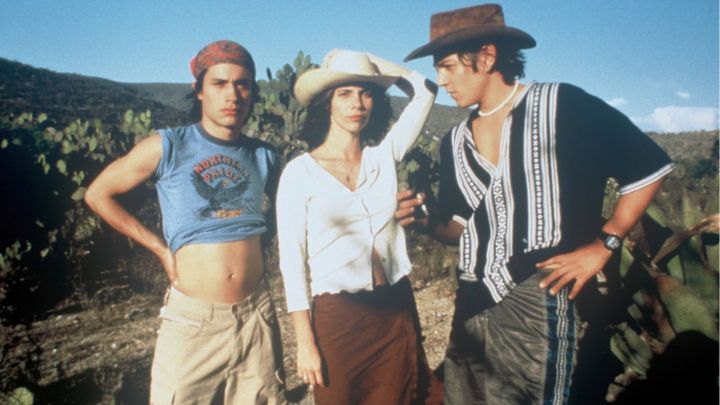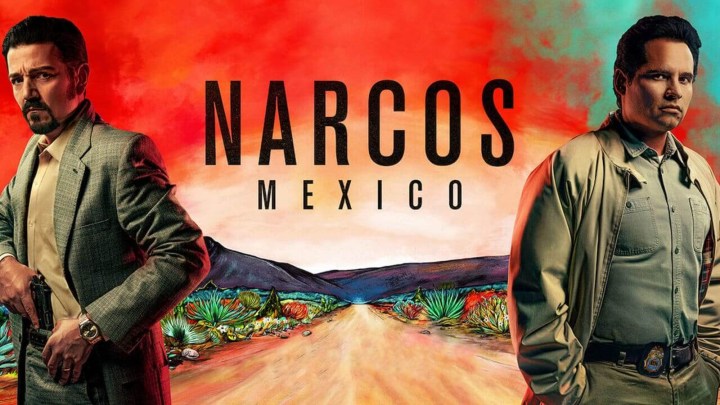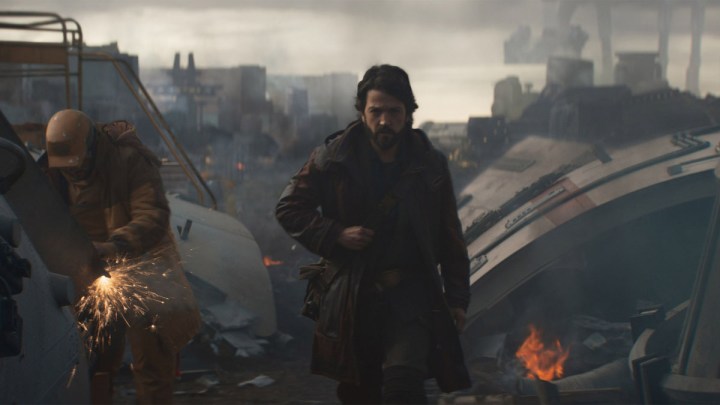Diego Luna is a star, or at least, he should be one. The 42-year-old Mexican is one of the most recognizable Latino talents in Hollywood, a consistently reliable working actor who delivers good and often great performances when given the chance. Luna has been in Hollywood for nearly twenty years, mainly playing supporting roles, and is finally stepping into the franchise spotlight with Tony Gilroy’s slow-burn space adventure Andor, the latest entry in the ever-expanding Star Wars universe. Andor, where he also serves as an executive producer, provides Luna with his first starring role since Netflix’s Narcos and represents his first chance to lead a major franchise since Rogue One: A Star Wars Story.
Reviews for Andor have been positive, with critics praising its slow approach and declaring it a breath of fresh air amid the increasingly formulaic projects that the Star Wars/Disney machine keeps churning out yearly. On a more personal level, Andor represents Luna’s chance to step up and prove he can carry a big-name IP on his back. Easier said than done, especially with a property like Star Wars, infamous for breaking many actors’ rising careers and having one of the most divided and openly confrontational fanbases. But Hollywood is experiencing a pivotal moment for inclusivity and support for Latino talent. And with Andor already renewed for a second season and critics and audiences rooting up for him, Luna has the chance to enter the next stage of his career. In his case, it truly is now or never.
From Mexico with love

Born in Toluca, Diego Luna has the arts running through his veins. His father, Alejandro Luna, is a theater, film, and opera set designer who encouraged his son to love and appreciate the arts, eventually leading him to pursue an acting career. Like his compatriots Salma Hayek, Eiza González, and his long-time best friend, Gael García Bernal, Luna had his beginnings on the small screen. Telenovelas are the best way for Mexican talent to make a name for themselves, providing them with enough acting experience to prepare them for the transition to Hollywood and endearing them to the Mexican audience.
Luna’s naturalistic and effortless charm was on full display from the very beginning; he often played spirited and relatable young men surrounded by chaotic circumstances. Never was his boyish appeal clearer than in Alfonso Cuarón’s 2001 road film Y Tu Mamá También, which catapulted him and co-star Gael García Bernal to international prominence. As Tenoch, Luna was a precocious talent who refused to be ignored. A coming-of-age story set against the backdrop of a pivotal time in Mexican politics, Y Tu Mamá También was a game-changer for Latino talent on the international stage. Not only did it make stars out of Cuarón, Luna, and García Bernal, but it redefined Mexican cinema’s reach and influence, starting a movement that placed Latino storytelling on a rising path.
By being front and center in the film that started it all, Luna and Bernal became unintentional but willing leaders of the movement. Their careers largely existed in parallel to one another, with each taking a distinctive and ultimately fruitful approach; whereas Luna favored supporting roles in such major Hollywood productions as Frida, The Terminal, Milk, and Elysium, Bernal focused on provocative and “daring,” often experimental projects that placed him front and center, like The Crime of Padre Amaro, Bad Education, and The Science of Sleep.
The result, however, was the same, as both Luna and García Bernal held the title of “most recognizable Mexican actors” in Hollywood for years — they still do, in fact. Well aware of their impact and the place their real-life friendship had on the cultural lexicon, Luna and Bernal co-starred in numerous films, although none were as influential as Y Tu Mamá También. Above all, the duo paved the way for future Latino talent in Hollywood by redefining the standards of who a leading man could be.
Breaking through

It could be easy to discard Luna’s influence in Hollywood — after all, he lacks the Oscar nomination that would turn him into a “prestige” actor or the major commercial hit that would make him a box-office draw. However, Luna’s career has something much more important: consistency. The actor has been working for over twenty years, never once failing to impress even in the smallest and most thankless roles. The longevity of his career speaks not only to his talent and resilience but his influence and impact on an industry that actively boxes Latino talent and encourages them to stay in their lane.
But Luna has never stayed in one lane, pursuing different venues, including producing and directing, exploring different genres like sci-fi and romantic comedy, and doing his utter best to break new ground for those coming after him. Luna has played the obligatory roles for a Latino working actor — mainly drug dealers and illegal immigrants –, but he’s never indulged their harmful tropes and conventionalities. There’s a dignity to his performances, a willingness to reject audiences’ expectations. Luna favors nuance and subtlety; even in Narcos‘ most brutal scenes, there’s a softness to his choices that makes him all the more compelling.
You could fault Luna for indulging Hollywood’s idea of Latino actors. You could also blame him for “glorifying” violence in a country that already endures too much of it. But there is no point in recriminating, especially when Luna has been very open about the physical and emotional hardships of playing such a figure. Actors act, and if we were to shun all who play reprehensible characters, there’d be no actors left to admire. The fact remains that Luna has been at the forefront of Latino advancement in Hollywood for years now, and his contributions often go overlooked. Narcos México gave him more exposure than any of his other projects in the 2010s, with the obvious exception of Rogue One.
We are at a crucial time for representation in Hollywood, and Latino talent is breaking casting boundaries. Luna’s Narcos co-star Tenoch Huerta will make a splash as Namor, the Submariner, in Ryan Coogler’s Black Panther: Wakanda Forever. And his best friend, Gael García Bernal, will make his MCU debut with the Werewolf By Night Disney+ Halloween special, an ode to creature features and B-horror movies of Hollywood’s Golden Age. Salma Hayek, Oscar Isaac, and Pedro Pascal continue striving to increase Latino exposure in Hollywood, finally breaking into the big-budget blockbuster territory that remained closed to them for years. With Andor, Luna joins them on the frontlines, but let’s not pretend like he hasn’t been fighting this war for decades now.
The rebel at the right time

Star Wars is in a weird place. The much-maligned prequels divided the fandom, and things only worsened once the sequels arrived. You could blame Disney — their factory-like approach to “content” is certainly responsible for some of the franchise’s problems — but there’s also a case to be made that the Star Wars universe was stretched too thin, too fast. The galaxy far, far away is certainly a compelling and fascinating universe, but does that mean audiences want to spend an unlimited amount of time in it?
Andor has been both praised and criticized for marking a stark departure from the Easter egg, fan-service-dominated landscape permeating over the last Star Wars projects. Tony Gilroy’s vigorous, grounded, almost naturalistic approach to the franchise feels like a breath of fresh air amid the murky, largely homogenous styles of previous Star Wars entries. But there’s a distinctive lack of “action” in Andor, especially considering its slow-burn approach to storytelling. Gilroy is more concerned with the human side of the “Wars,” favoring political intrigue and plot rather than action setpieces and Jedi fanfare. And while Andor is far from Succession in space, it’s far more narratively complex than something like Boba Fett.
Yet, therein lies its appeal. Andor can revitalize Star Wars and make it feel timely and meaningful again, and Luna is front and center, perhaps handling the biggest challenge of his career. It’s not a matter of whether he can do it — rest assured, he can — but rather one of whether he’ll be allowed to or fall prey to the Star Wars machine. After all, this is the franchise that kept Pedro Pascal hidden behind a helmet, wasted Ewan McGregor, and reduced Temuera Morrison to an afterthought in what was supposed to be his show. No IP chews and spits out actors like Star Wars does. But Luna has faced and conquered tougher challenges; aided by Tony Gilroy’s vision and a story that lends itself to a decidedly humanistic approach, his time in the spotlight might provide him with a showcase worthy of his talents.
It’s been a long road for Luna, but he’s stayed relevant and consistent, defying conventions and even expectations. It might be exaggerated and outright insulting to call Andor his reward, but it’s certainly an acknowledgment of the place he’s crafted for himself in Hollywood. If anything, beyond what Andor achieves for its struggling franchise, the show should have a lasting effect on Luna’s long-term career. If this is his equivalent of “one for them, one for me,” then we will pay close attention to see what this fascinating and versatile actor does next. Perhaps something with the Gilroys? A spiritual sequel to Nightcrawler has never sounded more appealing.



